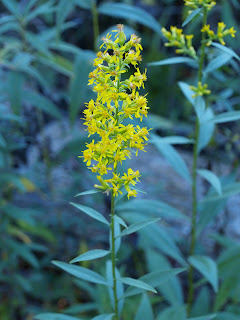Elizabeth & I headed out to the Sommes on a gorgeous Sunday morning, armed with our Swinks and a lofty ambition of becoming more familiar with those populous genera. I was feeling pretty confident, having received a rundown on them during one of the more recent botany walks. 'Tis folly to be confident in the Asteraceae, I have come to realize. We were able to figure out most of them, and I became able to distinguish a couple of my nemeses, A. shortii and A. sagittaria drummondii. They really don't look that much alike, aside from both being pale lavender and blooming at the same time, but I usually forget from fall to fall which is which. However, by the time we reached the southwest corner of SPG, where some huge trees were cleared a few years back, we became frustrated by a few confusing asters and accepted defeat. I have also come to realize that I am perplexed by hairy aster, A. pilosus, and think everything is it. As a botanist, I am rubbish [said with a British accent].
Here is a list of asters and goldenrods we saw, or at least think we saw:
Aster lateriflorus, shortii, sagittaria drummondii, laevis, azureus, furcatus, novae-angliae, praeltus, umbellatus, ericoides, pilosus, ontarionis (suspected);
Solidago caesia, ulmifolia, rigida, graminifolia, riddellii, gigantea, speciosa, rugosa, nemoralis, canadensis (blech).
The photos...some of the earlier-blooming ones were in sorry shape, so I have no photos. I've thrown in some photos of other fall lovelies, because it's not their fault they're not in the star genera:
Aster azureus, sky-blue aster
Aster ericoides, heath aster
Aster furcatus, forked aster
Aster laevis, smooth blue aster
Aster lateriflorus, side-flowering aster
Aster novae-angliae, New England aster
Allrighty. This is the stumper. We hesitatingly dubbed this Aster ontarionis, Ontario aster. The key in this section of the asters is brutal. It could also maybe be A. simplex, but it just didn't look that simplex-y to me.
Here's a closer look at it.
Aster pilosus, hairy aster. At least I think it is. Like I think every nondescript white aster is.
Aster praeltus, willow aster. It has a fleshy gestalt.
Aster sagittaria drummondii. Elizabeth pointed out the winged petioles which are an indicator. Hopefully I'll stop messing it up.
Here it is again, with flowers. Short, stubby little petals.
And here is what I always confuse it with, Aster shortii, Short's aster. It has longer petals and less numerous flowers.
A. shortii's leaves are "very neat", according to another botanist friend, Karen.
Aster umbellatus, flat-topped aster, looking a little blowsy and used-up this late in the season.
A little intermission, brought to you by the Gentianaceae. Check out the stripes in the throat of Gentiana crinita, fringed gentian!
Gentiana quinquefolia, stiff gentian. The gentians are beautiful, but they make me sad--the harbingers of the death and cold misery to come. I will never be one of those people who look forward to crisp fall weather.
And we're back! Solidago caesia, blue-stemmed goldenrod, with its ghostly, pale blue stem.
Solidago nemoralis, old-field goldenrod. I think that name is more romantic than its other, gray goldenrod, although you can definitely see in this photo where that name comes from.
Solidago riddellii, Riddell's goldenrod
Solidago rigida, stiff goldenrod
Solidago speciosa, showy goldenrod. It looks like a fairy wand to me.
Solidago ulmifolia, elm-leaved goldenrod, whose leaves look nothing like elm leaves. As an earlier-blooming goldenrod, it's a little past its prime.
Aaaaand Triosteum aurantiacum, orange-fruited horse gentian, whose specific epithet I've been mispronouncing for years. I was gently corrected this summer.
I'll leave you with a photo of one of the prairie openings at SPG...I walked through it with my arms brushing the tops of the Indian grass, like Kevin Costner in Dances With Wolves:

























No comments:
Post a Comment